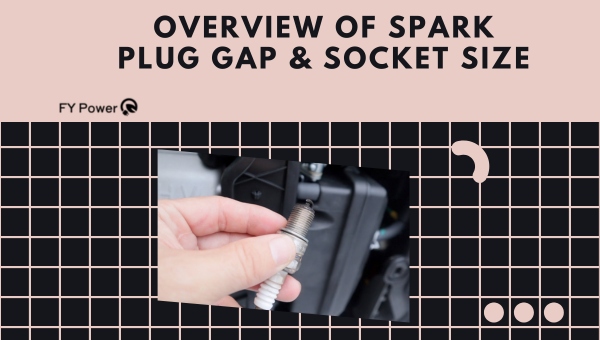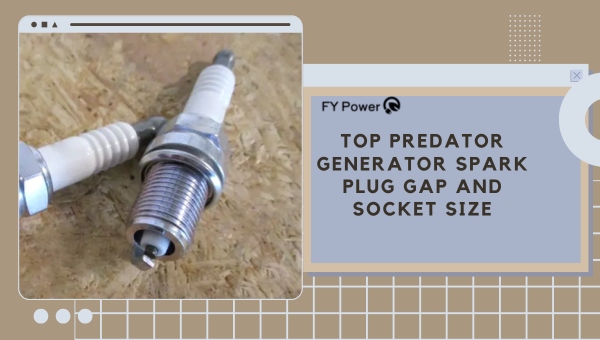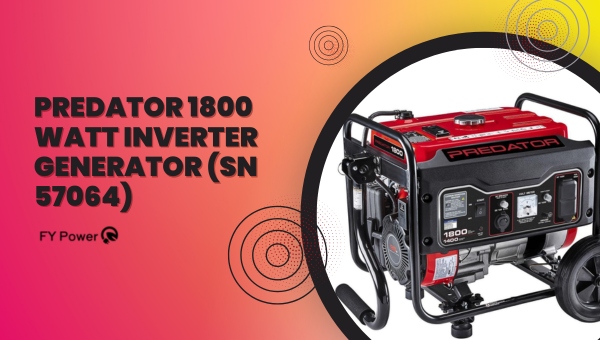Are you looking for an easy way to determine the Predator generators spark plug gap and socket size? If so, then this guide is just what you need.
In this guide, we will provide all the information you need in order to get the correct spark plug gap and socket size for your Predator generator.
We’ll also explain how to set up a gap gauge correctly so that you can ensure an accurate reading every time. So whether you’re replacing worn-out plugs or simply checking existing ones, this guide has everything you need to know!
Overview of Spark Plug Gap & Socket Size
If you own a Predator Generator, it’s important to know the spark plug gap and socket size for your model. Knowing this information can help you maintain your generator and keep it running smoothly.

The type of spark plug used in Predator Generators is the F6TC (Torch) type. The gap should be set at 0.028″ – 0.031″ (0.7-0.8 mm). The socket size is 13/16″ (21mm).
We recommend you, use an NGK-BPR6EIX Spark Plug for Predator 3500 Inverter Generator as a quick and easy upgrade from the stock spark plug, which is designed to operate over a much wider heat range than ordinary plugs and resists carbon buildup.
Related Post: Guide To Champion Generators Spark Plug Gap and Socket Size
Top Predator Generators Spark Plug Gap And Socket Size

Given below are some of the top models of predator generators and their park plug and socket sizes.
Predator 3500 Watt Inverter Generator (SN 56720 / 59137 /63584)
Gap: 0.027″– 0.031″ (0.7-0.8 mm) | Socket size: 13/16″ (21mm)
Spark Plug Gap
The Spark Plug Gap of the Predator 3500 Watt Inverter Generator (SN 56720 / 59137 / 63584) is an important feature as it helps to ensure that the engine functions properly.
The gap size determines how much electricity is transferred from the ignition coil to the engine. This particular model has a quite typical gap size, with a range of 0.027″–0.031″ (0.7-0.8 mm)
Socket Size
The socket size of the Predator 3500 Watt Inverter Generator (SN 56720 / 59137/ 63584) is an important component of the overall spark plug design.
This allows for the appropriate level of electricity to be transferred from the ignition coil to the engine. The socket size is typically 13/16″ (21mm).
Predator 1800 Watt Inverter Generator (SN 57064)

Gap: 0.028″−0.031″ (0.7-0.8 mm) | Socket size: 13/16″ (21mm)
Spark Plug Gap
The spark plug gap in the Predator 1800 Watt Inverter Generator should be set at 0.028″−0.031″ (0.7-0.8 mm). This ensures that the engine receives enough voltage to create a hot, powerful spark and efficient combustion of the air/fuel mixture.
Socket Size
The socket size of the Predator 1800 Watt Inverter Generator (SN 57064) is an essential component of its design. It acts as a conduit for transferring electricity from the ignition coil to the engine.
Which is crucial for proper spark plug operation and engine performance. The socket size recommended for this generator is 13/16″ (21mm).
Predator 2000 Watt Inverter Generator (SN 59135 /62523)
Gap: 0.023″– 0.027″ (0.6-0.7 mm) | Socket size:5/8″ (16mm)
Spark Plug Gap
The Spark Plug Gap of the Predator 2000 Watt Inverter Generator (SN 59135 /62523) is an essential feature that helps ensure the proper functioning of the engine.
The gap size determines how much electricity is transferred from the ignition coil to the engine and should be set between 0.023″–0.027″ (0.6-0.7mm).
Socket Size
It determines how effectively power is transferred from the generator to your appliances, tools, and other devices. The socket size of this particular model is 5/8″ (16mm).
Related Post: All Ryobi Generators Spark Plug Gap and Socket Size Guide
Predator 4000 Watt Generator (CARB / EPA III)
Gap: 0.027″– 0.031″ (0.7-0.8 mm) | Socket size:13/16″ (21mm)
Spark Plug Gap
The Predator 4000 Watt Generator (CARB / EPA III) is equipped with a spark plug gap of 0.027-0.031 inches (0.7-0.8 mm).
This spacing is important for the efficient operation of the generator engine and must be maintained for optimal performance.
Socket Size
The Socket Size of the Predator 4000 Watt Generator (CARB / EPA III) is an important factor that must be taken into consideration to ensure proper operation.
The socket size of this generator is 13/16″ (21mm). This socket size is necessary for the efficient functioning of all electrical components within the generator, such as spark plugs and other connections.
List Of All Predator Generators Spark Plug Gap And Socket Size
Predator 9500 Watt Inverter Generator (SN 57080)
- Type – BPR6ES (NGK) or equivalent
- Upgrade – BPR6EIX – NGK Iridium Spark Plug
- Gap – 0.028″– 0.031″ (0.7-0.8 mm)
- Socket size – 13/16″ (21mm)
Predator 9000 Watt Generator (CARB / EPA III)
- Type – F6TC (Torch)
- Gap – 0.028″ – 0.031″ (0.7-0.8 mm)
- Socket size – 13/16″ (21mm)
Predator 8750 Watt Inverter Generator (SN 57480)
- Type – F6RTC (Torch) or equivalent
- Gap – 0.028″ – 0.031″ (0.7-0.8 mm)
- Socket size – 13/16″ (21mm)
Predator 8750 Watt Generator (EPA III)
- Type – F6TC (Torch) or equivalent
- Gap – 0.028″ – 0.031″ (0.7-0.8 mm)
- Socket size – 13/16″ (21mm)
Predator 6500 Watt Generator (CARB / EPA III)
- Type – F6TC (Torch) or equivalent
- Gap – 0.028″– 0.031″ (0.7-0.8 mm)
- Socket size – 13/16″ (21mm)
Predator 4550 Watt Inverter Generator (SN 59303)
- Type – F6RTC (Torch) or equivalent
- Gap – 0.028″ – 0.031″ (0.7-0.8 mm)
- Socket size – 13/16″ (21mm)
Predator 4400 Watt Inverter Generator (SN 57509)
- Type – F6RTC (Torch) or equivalent
- Gap – 0.028″ – 0.031″ (0.7-0.8 mm)
- Socket size – 13/16″ (21mm)
Predator 4375 Watt Generator (CARB / EPA III)
- Type – F6TC (Torch) or equivalent
- Gap – 0.027″– 0.031″ (0.7-0.8 mm)
- Socket size – 13/16″ (21mm)
Predator 4000 Watt Generator (CARB / EPA III)
- Type – F6TC (Torch) or equivalent
- Gap – 0.027″– 0.031″ (0.7-0.8 mm)
- Socket size – 13/16″ (21mm)
Predator 3500 Watt Inverter Generator (SN 56720 / 63584)
- Type – F7RTC (Torch) or equivalent
- Upgrade – BPR6EIX – NGK Iridium Spark Plug
- Gap – 0.027″– 0.031″ (0.7-0.8 mm)
- Socket size – 13/16″ (21mm)
Predator 2000 Watt Inverter Generator (SN 62523)
- Type – A5RTC (Torch) or equivalent
- Gap – 0.023″– 0.027″ (0.6-0.7 mm)
- Socket size – 5/8″ (16mm)
Predator 1800 Watt Inverter Generator (SN 57064)
- Type – E6RTC (LG)
- Gap – 0.028″−0.031″ (0.7-0.8 mm)
- Socket size – 13/16″ (21mm)
Predator 1400 Watt Inverter Generator (SN 57063)
- Type – A5RTC (Torch) or equivalent
- Gap – 0.024″– 0.028″ (0.6-0.7 mm)
- Socket size – 5/8″ (16mm)
Related Post: Guide To All Honda Lawn Mowers Spark Plug Gap & Socket Size
Benefits of Setting the Correct Spark Plug Gap & Socket Size
When it comes to spark plugs, setting the correct gap and socket size is essential for optimal engine performance. Here are some of the benefits of using the right spark plug gap and socket size.
- Improved fuel efficiency: Setting the correct spark plug gap and socket size helps ensure that your engine is running at its most efficient level, which can help you save on fuel costs.
- Increased power output: When your engine is running at its peak efficiency, it will be able to generate more power than if it was running with an incorrect spark plug gap or socket size.
- Reduced emissions: A properly tuned engine will produce fewer emissions than one that is not correctly tuned. This can help reduce air pollution and improve overall air quality.
- Longer life span: By ensuring that your engine is running at its peak efficiency, you can extend its life span significantly. This means that you won’t have to replace your spark plugs as often and can save money in the long run.
Overall, setting the correct spark plug gap and socket size for your Predator generator is essential for ensuring optimal performance. Not only will you save on fuel costs and emissions, but you’ll also be extending the life of your engine. So, take the time to make sure that your spark plugs are set up correctly and that your socket size matches
How to Install a New Spark Plug in Predator Generator?
Installing a new spark plug in your Predator Generator is an easy task that can be done in just a few steps.
First, you will need to determine the type of spark plug that is compatible with your generator. The most common type for Predator Generators is the BPR6ES (NGK) or equivalent. You may also want to consider upgrading to an NGK Iridium Spark Plug (BPR6EIX).
Once you have determined the correct type of spark plug, you will need to adjust the gap between the electrodes. This should be set at 0.028”-0.031” (0.7-0.8 mm). If necessary, use a feeler gauge to measure and adjust the gap accordingly.
Next, remove the old spark plug from its socket using a ratchet and socket wrench and replace it with the new one. Make sure that it is firmly seated before tightening it securely with your wrench.
Finally, check all connections and ensure that everything is properly tightened before starting up your generator again.
Related Post: All Generac Portable Generators Spark Plug Gap & Socket Size
Tips on Maintaining your Predator Generator’s Spark Plug
Maintaining your Predator Generator’s spark plug is an important part of keeping it in good working order. Here are some tips to help you keep your generator running smoothly.
- Disconnect the spark plug cap from the end of the plug and clean out any debris that has accumulated around it.
- Using a spark plug wrench, remove the old spark plug and replace it with a new one.
- Make sure to check the gap between the electrodes on the new spark plug and adjust it if necessary.
- Reattach the spark plug cap securely and make sure all connections are tight before starting up your generator.
These simple steps can help ensure that your Predator Generator runs smoothly and efficiently.
Conclusion
The Predator Generator Spark Plug Gap & Socket Size Guide is a helpful resource for anyone looking to replace the spark plug in their Predator generator.
This guide provided you with information on the type of spark plug, gap size, socket size, and other important details needed to ensure a successful installation.
It also includes cross-reference charts and links to manuals for specific models. Follow the steps outlined in this guide, and you’ll have a generator that runs smoothly for years to come!

